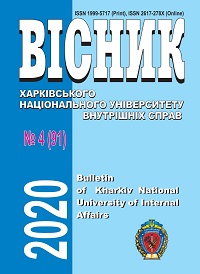Circumstances for Committing Crimes in the Banking Sector: Normative and Legal Aspect
DOI:
https://doi.org/10.32631/v.2020.4.28Keywords:
normative and legal regulation of banking system, forensic provision, conditions and circumstances for committing crimes, economic crimes within banking sector.Abstract
The historical way of the development of banking business and the state of its legislative provision, which had an impact on criminal behavior in this area, has been studied. It has been noticed that the responsible officials of banking institutions, due to their high level of education, skillfully used gaps or contradictions in the legislation for the useful purposes of illegal enrichment. They quickly adapt to amendments in normative and legal regulation and invent new schemes of criminal technology.
The key factors in the situation of committing crimes in the presented area are: search for opportunities for criminal enrichment by using existing powers; conspiracy of officials of commercial banks with representatives of supervisory agencies (curators from some units of the National Bank of UKraine) in order to cover up criminal activity; development of a plan of financial fraud with representatives of commercial organizations in order to steal the entrusted funds and their further legalization. Typically, such criminal “associations” try to have long-term relationships under the guise of corrupt relations with supervisors and banking secrecy in order to systematically generate illicit proceeds. In case of the risk of detecting criminal schemes, the banking institution may be brought to bankruptcy, which is used as the method to hide traces of criminal activity.
Analysis of the impact of regulatory factor in the context of committing economic crimes in the banking sector is a perspective and relevant area of further research. In this regard, the development of the doctrine of forensic forecasting in conditions of instability of processes in the economy in its individual segments (lending, currency regulation), weak control over the conduct and accounting of banking transactions, etc. is of great importance.
Equally important is the development of cooperation between law enforcement agencies involved in the fight against crime in the banking sector, with the units of the National Bank, the State Fiscal Service and financial monitoring; the improvement of the methodology of conducting certain types of examinations, etc. Provisions for such cooperation are enshrined in law and are in force, but some need to be revised in the light of central government reforms.
Downloads
References
Matusovskii G.A., 1999. Economic crime: forensic analysis [Ekonomicheskie prestupleniya: kriminalisticheskii analiz]. Kharkov: Konsum.
Volobuiev A.F., 2001. Forensic characteristics of crimes in the field of credit relations [Kryminalistychna kharakterystyka zlochyniv u sferi kredytnykh vidnosyn]. Pìdpriêmnictvo, gospodarstvo ì pravo – Entrepreneurship, Economy and Law, No. 7, pp. 82-85.
Satuev R.S., Shraer D.A. and Yas`kova N.Yu., 2000. Economic crime in the financial and credit system [Ekonomicheskaya prestupnost` v finansovo-kreditnoi sisteme]. Moscow: Tsentr ekonomiki i marketinga.
Stepaniuk R.L., 2012. Forensic support for the investigation of crimes committed in the budget sphere of Ukraine [Kryminalistychne zabezpechennia rozsliduvannia zlochyniv, vchynenykh u biudzhetnii sferi Ukrainy]. Kharkiv: NikaNiva. (Ed.: Volobuiev A.F.).
Popovych V.M., 1995. Legal bases of banking and its protection from criminal encroachments: a table book on banking and business economic security [Pravovi osnovy bankivskoi spravy ta yii zakhyst vid zlochynnykh posiahan: nastolna knyha z pytan bankivskoi ta pidpryiemnytskoi ekonomichnoi bezpeky]. Kyiv: Diia-plius.
Cherniavskyi S.S., 2010. Theoretical and practical bases of methods of investigation of financial fraud [Teoretychni ta praktychni osnovy metodyky rozsliduvannia finansovoho shakhraistva]. Abstract of D.Sc. dissertation. National Academy of Internal Affairs.
Holovina V.P., 2004. Fundamentals of the methodology of investigation of legalization (laundering) of money obtained by criminal means, using the credit and banking system [Osnovy metodyky rozsliduvannia lehalizatsii (vidmyvannia) hroshovykh koshtiv, zdobutykh zlochynnym shliakhom, z vykorystanniam kredytno-bankivskoi systemy]. Abstract of Ph.D. dissertation. National Academy of Internal Affairs of Ukraine.
Moroz A.M., Pukhovkina M.F. and Savluk M.I., 2005. Central bank and monetary policy [Tsenralnyi bank ta hroshovo-kredytna polityka]. Kyiv: Vydavnytstvo KNEU. (Ed.: Moroz A.M.).
Bovykin V.I., 1967. Formation of financial capital in Russia (1880-1908) [Formirovanie finansovogo kapitala v Rossii (1880-1908 gg.)]. Moscow: Nauka.
Ostoumov S.S., 2001. Crime and its causes in pre-revolutionary Russia [Prestupnost` i ee prichiny v dorevolyutsionnoi Rossii]. Moscow: Norma-Infra.
Volzhenkin B.V., 2002. Crimes in the field of economic activity [Prestupleniya v sfere ekonomicheskoi diyatel`nosti]. St. Petersburg: Yuridicheskii tsentr Press.
Kal`nitskii M., 2006. Credit history [Kreditnaya istoriya]. Kontrakty, No. 12, pp. 20-23.
Korniienko V.V., 2015. Forensic characteristics of the person of the offender and criminal groups in the field of banking [Kryminalistychna kharakterystyka osoby zlochyntsia ta zlochynnykh hrup u sferi bankivskoi diialnosti]. Pravo bezpeka, No. 2, pp. 98-102.



